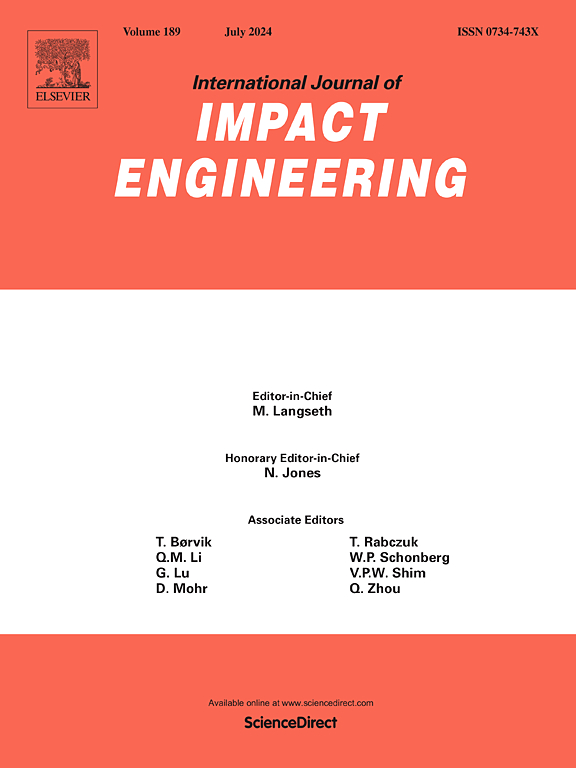High-fidelity prediction of low-velocity impact damage in straight and variable angle fibre laminates with a semi-discrete continuum damage mechanics approach
IF 5.1
2区 工程技术
Q1 ENGINEERING, MECHANICAL
International Journal of Impact Engineering
Pub Date : 2025-06-08
DOI:10.1016/j.ijimpeng.2025.105434
引用次数: 0
Abstract
Accurate and efficient finite element modelling of Low-Velocity Impact (LVI) damage in laminated composites remains highly sought, due to the poor detectability and quantifiability of this damage by physical means. In this work, a novel semi-discrete continuum damage model is applied to simulate LVI-induced damage in multidirectional laminates within a ply-by-ply modelling framework. Contrary to the standard practice that requires fibre-aligned individual ply meshes held together by kinematic constraints at mismatched mesh interfaces, the present mesh orientation-independent crack model is able to use a uniform mesh pattern for the entire laminate, reducing the meshing burden substantially. Additionally, the computational time gets reduced due to the elimination of kinematic constraints from the system of equations. Three challenging examples are presented involving LVI on a cross-ply, multidirectional straight fibre and a variable angle tow (VAT) fibre laminate, showing the method’s general applicability. In all cases, the overall laminate behaviour upon impact, the network of complex cracks, including the curvilinear crack profile development in a VAT laminate, and the intricate crack-delamination interaction as seen in experiments, are reproduced with high fidelity.
用半离散连续损伤力学方法高保真地预测直、变角度纤维层合板的低速冲击损伤
由于层合复合材料低速冲击损伤的物理检测和量化能力较差,因此准确、高效的层合复合材料低速冲击损伤有限元建模一直受到人们的高度关注。在这项工作中,采用一种新颖的半离散连续损伤模型,在一层一层的建模框架内模拟了lvi引起的多向层压板损伤。与标准做法相反,要求在不匹配的网格界面上通过运动学约束将纤维对齐的单个层网格结合在一起,目前的网格方向无关的裂纹模型能够为整个层压板使用统一的网格模式,从而大大减少了网格划分负担。此外,由于消除了方程组中的运动约束,计算时间得到了减少。在交叉铺层、多向直纤维和变角束(VAT)纤维层压板上提出了三个具有挑战性的LVI示例,显示了该方法的一般适用性。在所有情况下,冲击时的整体层压板行为,复杂裂纹网络,包括VAT层压板中的曲线裂纹轮廓发展,以及实验中看到的复杂裂纹-分层相互作用,都以高保真度重现。
本文章由计算机程序翻译,如有差异,请以英文原文为准。
求助全文
约1分钟内获得全文
求助全文
来源期刊

International Journal of Impact Engineering
工程技术-工程:机械
CiteScore
8.70
自引率
13.70%
发文量
241
审稿时长
52 days
期刊介绍:
The International Journal of Impact Engineering, established in 1983 publishes original research findings related to the response of structures, components and materials subjected to impact, blast and high-rate loading. Areas relevant to the journal encompass the following general topics and those associated with them:
-Behaviour and failure of structures and materials under impact and blast loading
-Systems for protection and absorption of impact and blast loading
-Terminal ballistics
-Dynamic behaviour and failure of materials including plasticity and fracture
-Stress waves
-Structural crashworthiness
-High-rate mechanical and forming processes
-Impact, blast and high-rate loading/measurement techniques and their applications
 求助内容:
求助内容: 应助结果提醒方式:
应助结果提醒方式:


